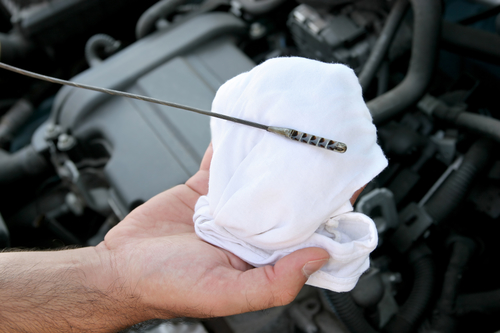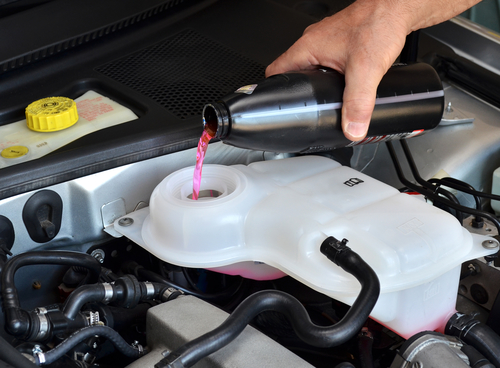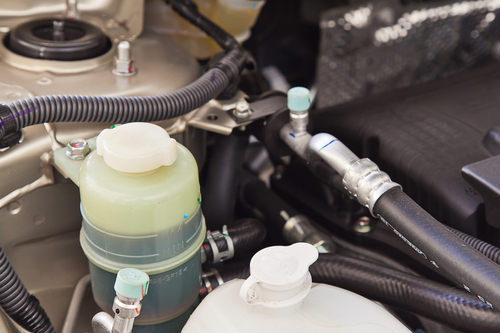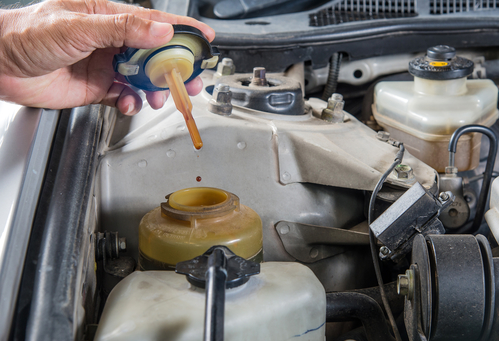One of the most important ways to help your vehicle live a long and happy life is through basic maintenance of its fluids. Regardless of your engine knowledge, anyone who can lift the hood of their car can check most of the fluids. Let’s break down which of these you can easily check and change yourself, and how to do so.
Top 4 Engine Fluids to Keep an Eye On
-
Oil:
It’s no surprise to anyone that oil is a vital component – without it, your engine just won’t run. Thankfully, its super easy to check, and this process is streamlined across all vehicles.
Simply pop the hood, pull the dipstick out and give it a wipe down. Then, insert it all the way back into its tube, pull it out again and take look to see where the oil is at the end. You may want to repeat this process a second time if you aren’t sure.
Every dipstick will be marked with “Low,” “Safe” and “High” zones, so it’s easy to tell if you need to top it up. If you do add some oil, be sure to start your vehicle and let it run for a minute afterward, then check the oil level again.
Be sure to take note of the oil’s color. Oil that is black or grainy in texture could mean it is dirty and needs to be changed. Also, look out for any light or milk appearance – this could indicate that coolant is leaking into the engine. If this is the case, take the vehicle to a professional right away.
-
Coolant:
Coolant, or anti-freeze, is another important fluid to keep an eye on. Nearly 30% of the energy produced from gasoline in your engine ends up as waste, in either the form of exhaust or heat. Coolant keeps this heat from festering, so your engine doesn’t overheat and break down.
To check your coolant, just pop the hood of your car and find your coolant reservoir. It should be easy to identify as a large plastic container near the outer part of the engine. It is most likely located right beside your windshield washer fluid reservoir.
Without even opening the cap, you can see your coolant level externally, as there is a “full” line engrained in the plastic. If it isn’t full, simply pop the cap off and fill it up! Certain coolants will require mixing with water, while others will be pre-mixed. Be sure to check the product requirements first.
-
Brake Fluid:
Also, known as “hydraulic fluid,” brake fluid has a highly important role. The term ‘hydraulic’ literally means ‘to be moved or powered by fluids.’ This is how your vehicle brakes work; the fluid allows your brake parts to move properly and efficiently so that when you hit your brakes, your car actually stops.
Brake fluid must work under specific heat and pressure conditions in order to be effective. Be sure to keep it topped up and fresh!
Your vehicle’s hydraulic fluid reservoir should be easy to find as a clearly marked, clear-colored container. It will have defined minimum and maximum lines, making it easy to check. If your brake fluid is low, fill it up right away. Then have a professional check it out. Low brake fluid may be indicative of a system leak or worn brake pads.
-
Power Steering Fluid:
Ever notice when you’re driving that you can just turn the wheel nicely in the direction you want to go – without getting a serious arm workout in? That is all thanks to your vehicle’s power steering system. Your power steering fluid is another hydraulic fluid working within your engine. It allows the transmission of power in your power steering system.
Over time, the components of this system will begin to wear and the hydraulic fluid will get low and become contaminated. Because the fluid works directly in conjunction with the power steering pump, not keeping it fresh and clean can cause the pump to fail prematurely.
Before you check your power steering fluid, first start up your engine and turn your wheel in each direction fully a few times. Then turn off the engine and pop the hood.
The power steering fluid reservoir should be clearly marked and easy to find. To check it, look at the dipstick, much like the process of checking the oil. Or, if it doesn’t have a dipstick, simply remove the cap and look inside. If it is low, fill it up. Check your vehicle’s owner manual to determine how frequently you need to change your power steering fluid, as it will vary based on the make and model.
At Berryman Products, we are committed to answering and offering advice on all your engine-related questions. We provide the highest quality of products to keep your engine in tip-top shape. Contact us today for more information, or to ask a question!





